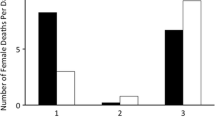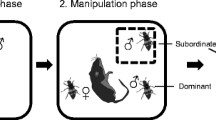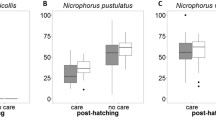Summary
Male and female burying beetles (Nicrophorus orbicollis) bury and preserve small carcasses which become food for their young. Typically, females remain with the brood until after larval development is complete, but males leave about 3 days after larvae hatch. In the absence of competitors, the effect of male presence throughout larval development is to reduce the size and weight of the brood on small carcasses, but not on larger ones. However, male assistance greatly reduces the probability that a conspecific competitor will usurp the carcass and kill the brood. A dynamic optimization model of the duration of paternal care is developed and the daily probabilities of discovery by conspecific competitors and of finding a new reproductive opportunity are varied. The model predicts that the duration of care should not be very sensitive to either the intensity of competition or the probability of finding another carcass. For a given probability of discovery by an intruder, the probability of finding a new carcass affects the duration of care in a stepwise fashion such that males should either provide no care or remain 10 days on large carcasses and 9 days on small ones (3 days after larvae hatch, in each case). The model also suggests that by providing an average of 9.5 days of care in nature, males act as if there is a negligible chance of having another brood, i.e. they are maximizing their reproductive success with their current brood.
Similar content being viewed by others
References
Andersson, M., Wiklund, C.G. and Rungren, H. (1980) Parental defense of offspring: a model and an example.Anim. Behav. 28, 536–42.
Bartlett, J. (1988) Male mating success and paternal care inNicrophorus vespilloides (Coleoptera: Silphidae).Behav. Ecol. Sociobiol. 23, 297–303.
Bartlett, J. and Ashworth, C.M. (1988) Brood size and fitness inNicrophorus vespilloides (Coleoptera: Silphidae).Behav. Ecol. Sociobiol. 22, 429–34.
Chase, I.D. (1980) Cooperative and noncooperative behavior in animals.Am. Nat. 115, 827–57.
Fetherston, I.A., Scott, M.P. and Traniello, J.F.A. (1990) Parental care in burying beetles: the organization of male and female brood-care behavior.Ethology 85, 177–90.
Foulds, L.R. (1981)Optimization Techniques. Springer-Verlag, NY, USA.
Gladstein, D.S., Carlin, N.F., Austad, S.N. and Bossert, W.H. (1991) The need for sensitivity analyses of dynamic optimization models.Oikos 60, 121–6.
Grafen, A. and Sibley, R. (1978) A model of mate desertion.Anim. Behav. 26, 645–52.
Houston, A.I. and Davies, N.B. (1985) The evolution of cooperation and life history in the dunnock,Prunella modularis. InBehavioural Ecology: The Ecological Consequences of Adaptive Behaviour (R. Sibley and R. Smith, eds), pp. 471–87. Blackwell, Oxford, UK.
Lazarus, J. (1990) The logic of mate desertion.Anim. Behav. 39, 672–84.
Mangel, M. and Clark, C.W. (1988)Dynamic Modeling in Behavioral Ecology. Princeton University Press, Princeton.
Maynard Smith, J. (1977) Parental investment: a prospective analysis.Anim. Behav. 25, 1–9.
Nur, N. (1984) Feeding frequencies of nestling blue tits (Parus caeruleus): costs, benefits and a model of optimal feeding frequency.Oecologia 65, 125–37.
Parker, G.A. and Maynard Smith, J. (1990) Optimality theory in evolutionary biology.Nature 348, 27–33.
Paterson, C.B., Erckmann, W.J. and Orians, G.H. (1980) An experimental study of parental investment and polygyny in male blackbirds.Am. Nat. 116, 757–69.
Pukowski, E. (1933) Ökologische untersuchungen anNecrophorus F.Z. Morph. Okol. 27, 518–86.
Regelmann, K. and Curio, E. (1986) How do great tits (Parus major) pair mates cooperate in brood defense?Behaviour 97, 10–36.
Rice, W.R. (1989) Analyzing tables of statistical tests.Evolution 43, 223–5.
Sargent, R.C. and Gross, M.R. (1986) Williams' principle: an explanation of parental care in teleost fishes. InThe Behavior of Teleost Fishes (T.J. Pitcher, ed.) pp. 275–93. Johns Hopkins University Press, Baltimore, USA.
Scott, M.P. (1989) Male parental care and reproductive success in the burying beetleNicrophorus orbicollis.J. Insect. Behav. 2, 133–7.
Scott, M.P. (1990) Brood guarding and the evolution of male parental care in burying beetles.Behav. Ecol. Sociobiol. 26, 31–9.
Scott, M.P. and Traniello, J.F.A. (1990) Behavioural and ecological correlates of male and female parental care and reproductive success in burying beetles (Nicrophorus spp.).Anim. Behav. 39, 274–83.
Townsend, D.S. (1986) The costs of male parental care and its evolution in a Neotropical frog.Behav. Ecol. Sociobiol. 19, 187–95.
Trivers, R.L. (1972) Parental investment and sexual selection. InSexual Selection and the Descent of Man (B. Campbell, ed.), pp. 139–79. Aldine, Chicago, USA.
Trumbo, S.T. (1990) Interference competition among burying beetles (Silphidae,Nicrophorus).Ecol. Entomol. 15, 347–55.
Trumbo, S.T. (1991) Reproductive benefits and the duration of paternal care in a biparental burying beetle,Necrophorus orbicollis.Behaviour 117, 82–105
Vehrencamp, S.L. and Bradbury, J.W. (1984) Mating systems and ecology. InBehavioural Ecology: An Evolutionary Approach (J.R. Krebs and N.B. Davies, eds),2nd edn, pp. 251–78. Sinauer, Sunderland, MA, USA.
Winkler, D.W. (1987) A general model for parental care.Am. Nat. 130, 526–43.
Winkler, D.W. and Wilkinson, G.S. (1988) Parental effort in birds and mammals: theory and measurement. InOxford Surveys in Evolutionary Biology, Vol. 5 (P.H. Henry and L. Partridge, eds), pp. 185–214. Oxford University Press, Oxford, UK.
Zeh, D.W. and Smith, R.L. (1985) Paternal investment by terrestrial arthropods.Am. Zool. 25, 785–805.
Author information
Authors and Affiliations
Rights and permissions
About this article
Cite this article
Scott, M.P., Gladstein, D.S. Calculating males? An empirical and theoretical examination of the duration of paternal care in burying beetles. Evol Ecol 7, 362–378 (1993). https://doi.org/10.1007/BF01237868
Issue Date:
DOI: https://doi.org/10.1007/BF01237868




